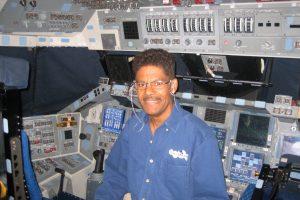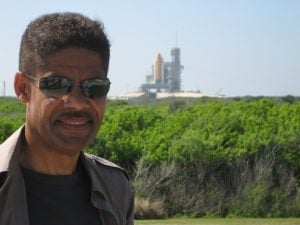
Ken Phillips has served as curator of aerospace science at the California Science Center in Los Angeles since 1990 and is responsible for shaping its exhibits and programs in aeronautics and space exploration. In 1991, he began planning a display of a flown space shuttle orbiter that culminated in NASA awarding the Space Shuttle Endeavour to the California Science Center two decades later. He is now working on the 200,000 square-foot Samuel Oschin Air and Space Center for which groundbreaking occurred in June 2022.
Ken has taught numerous courses in astrophysics, planetary geology, and space exploration to primary and secondary school students, and is an adjunct professor of the practice of physics and astronomy at the University of Southern California (USC). Through the USC Prison Education Program, he also teaches introductory astronomy to students in correctional facilities.
He received his bachelor’s in physics from North Carolina A&T State University, a master’s in general engineering from the University of Wisconsin, and a doctorate in environmental engineering from Hopkins.
What made you choose Johns Hopkins?
Hopkins was always a familiar institution, having grown up in Baltimore with grandparents living in the shadow of the Johns Hopkins School of Medicine. One day, while working at Greiner Engineering Sciences, Inc., the vice president rewarded us a day off after a grueling three-week rush to complete an environmental impact statement for a client. That day, I drove from the office in Cross Keys to the Homewood campus, walked into the graduate students’ admissions office, and declared my intention to study for a doctorate in environmental engineering.
My department chair, M. Gordon Wolman (lovingly known by all as “Reds”), happened to have been a peer and Lacrosse teammate of the vice president who had given me the day off. My boss must have written a most persuasive letter of support, since I was admitted to JHU and, between Greiner and Hopkins, was provided full tuition for my entire period of study.
Do you have any memories that stand out from your time as a student?
 There were many, but two stand out. Most endearing were the evenings that new graduate students would spend at the lovely home of Professor Wolman and his family. We would sit in his living room in Mount Washington with their big Labrador Retriever and discuss topics related to geomorphology, hydrology, environmental equity, and the interface between environmental engineering and public policy.
There were many, but two stand out. Most endearing were the evenings that new graduate students would spend at the lovely home of Professor Wolman and his family. We would sit in his living room in Mount Washington with their big Labrador Retriever and discuss topics related to geomorphology, hydrology, environmental equity, and the interface between environmental engineering and public policy.
The other was meeting my wife, Kathy Sanders, also a JHU alum. She did her doctoral work in psychology, which shared part of Ames Hall with the Engineering Department. Although not a coffee drinker, I made excuses every day to visit the coffee pot in the office that Kathy shared with three other psych grad students at the end of our hall.
Do you have any advice for aspiring engineers?
My experience has convinced me that the universe doesn’t want you to sit safely. It wants you to play ball, get in the game. You will never be entirely certain of any decision, nor will you ever have perfect information or all the answers when embarking on a new adventure. But that doesn’t matter, because it’s all about figuring it out.
While your training is necessary, it’s far from sufficient. It’s passion for being in the game that counts and, in the end, will take you far beyond the boundaries of your training.
Where are you working now? How did you get involved in this line of work?
After graduating in 1976, I joined the RAND Corporation in Santa Monica to work on an environmental engineering project taking place in the Netherlands studying water quality and hydrology. While at RAND, I got interested in how the sensors used for environmental assay could also be used for battlefield surveillance and intelligence gathering from space orbit. I also got interested in how those assets reached orbit through propulsion and the various parameters associated with observing the Earth from space.
The transition from environmental engineering to national security aerospace research began when I started teaching aeronautics and rocketry in the Saturday Excell program hosted by the Los Angeles Council of Black Professional Engineers. I loved teaching, and when the California Science Center advertised its need for someone to direct the development of its new aeronautics and space exploration wing, I couldn’t resist—it was a tailor-made position. It also led to my appointment in Physics and Astronomy at USC, which allows me to balance classroom teaching with the exhibit development work at the Science Center.
Why and how do you choose to stay connected to Johns Hopkins as an alumnus?
Hopkins was a critical onramp to my amazing career opportunities. The institution is a national treasure that’s providing similar opportunities for many others and leading the pack with breakthrough research in every area that it touches.
My wife and I make every effort to participate in JHU West-Coast events, providing support to prospective students, speaking with early and mid-career alums with an interest in career paths similar to our own, and financially giving back as much as possible. I was very pleased to have hosted a large group of West-Coast JHU alumni at the California Science Center when faculty from the Whiting School shared their exciting research on a trip through California some years ago.